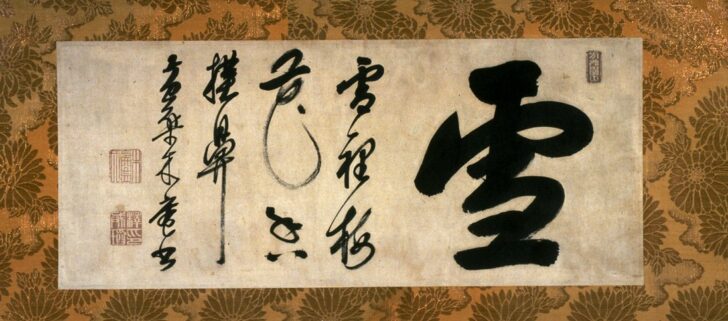Snow: calligraphy scroll
Muan Xingtao

Description
Muan Xingtao
China, 1611–1684
Snow
Edo Period (1615–1868)
ca. 1655–75
Hanging scroll, ink on paper
Museum purchase made possible by the Margaret Watson Parker
Art Collection Fund, 1986/1.205
Muan Xingtao (known in Japan as Mokuan) was a native of Fujian,
China. He took his monastic vows at the age of eighteen and in 1655
followed his mentor to Japan, where he helped to found several
monasteries. A mere decade later, he became the second abbot of
Manpukuji in Uji, the great Obaku Zen sect’s monastery on the
outskirts of Kyoto. Later he moved to Edo (present day Tokyo), where
he influenced the highest members of the military government.
Muan’s calligraphy was much admired and is immediately
recognizable. He often wrote inscriptions like this one, which
reads: “Snow: the fragrance of the plum blossoms in snow catches
my nose.” The large block characters drawn with thick, unhurried,
even strokes in dense black ink, are juxtaposed with smaller running
script characters rapidly brushed with strokes of varying thickness, a
pronounced diagonal tilt, and sharp edges.
2021 Gallery Rotation
__________
Muan Xingtao (known in Japan as Mokuan) was a native of Fujian, China. He took the tonsure at Wanfusi Monastery at the age of eighteen. In 1655, he followed his mentor to Japan, where he helped to found several monasteries. A mere decade later, Muan became the second abbot of Manpukuji in Uji, the great Ôbaku monastery on the southern outskirts of Kyoto. Later still he moved to Edo, where he was influential among the highest members of the military government. His calligraphy was much admired.
Muan’s hand in his formal calligraphy works is immediately recognizable: he often wrote inscriptions like the one seen here, where he juxtaposes one large character in block script with lines of smaller characters in running script. The large characters are drawn with unhurried, thick, even strokes in dense, unbroken black ink with blunt contours. The smaller characters are brushed rapidly, with strokes of varying thickness, a pronounced diagonal tilt, and sharp edges.
The calligraphy can be translated as "Snow: the fragrance of the plum blossoms in snow catches my nose."
Arts of Zen, February 15-June 15, 2003
M.Graybill, Senior Curator of Asian Art
Muan Xingtao (known in Japan as Mokuan) was a native of Fujian, China. He took his monastic vows at Wanfusi Monastery at the age of eighteen and in 1655 followed his mentor to Japan, where he helped to found several monasteries. A mere decade later, Muan became the second abbot of Manpukuji in Uji, the great Ôbaku Zen sect’s monastery on the southern outskirts of Kyoto. Later still he moved to Edo (present day Tokyo), where he was influential among the highest members of the military government. Muan’s calligraphy was much admired and is immediately recognizable. He often wrote inscriptions like the one seen here, in which a large character in block script is juxtaposed with lines of smaller characters in running script. The large characters are drawn with unhurried, thick, even strokes in dense, unbroken black ink with blunt contours, while the smaller characters are brushed rapidly, with strokes of varying thickness, a pronounced diagonal tilt, and sharp edges.
The calligraphy reads, “Snow: the fragrance of the plum blossoms in snow catches my nose.”
Winter 2011 Gallery Rotation
Muan Xingtao (Muan Hsing-t’ao, J. Mokuan)
China, 1611–1684
Snow
Edo Period (1615–1868)
circa 1655–75
Hanging scroll, ink on paper
Museum purchase made possible by the Margaret Watson Parker Art Collection Fund, 1986/1.205
Muan Xingtao (known in Japan as Mokuan) was a native of Fujian, China. He took his monastic vows at Wanfusi Monastery at the age of eighteen and in 1655 followed his mentor to Japan, where he helped to found several monasteries. A mere decade later, Muan became the second abbot of Manpukuji in Uji, the great Ôbaku Zen sect’s monastery on the southern outskirts of Kyoto. Later still he moved to Edo (present day Tokyo), where he was influential among the highest members of the military government. Muan’s calligraphy was much admired and is immediately recognizable. He often wrote inscriptions like the one seen here, in which a large character in block script is juxtaposed with lines of smaller characters in running script. The large characters are drawn with unhurried, thick, even strokes in dense, unbroken black ink with blunt contours, while the smaller characters are brushed rapidly, with strokes of varying thickness, a pronounced diagonal tilt, and sharp edges.
The calligraphy reads, “Snow: the fragrance of the plum blossoms in snow catches my nose.”
Subject Matter:
Muan Xingtao (known in Japan as Mokuan) was a native of Fujian, China. He took his monastic vows at Wanfusi Monastery at the age of eighteen and in 1655 followed his mentor to Japan, where he helped to found several monasteries. Muan became the second abbot of Manpukuji in Uji, the great Ôbaku Zen sect’s monastery on the southern outskirts of Kyoto.
The calligraphy reads, “Snow: the fragrance of the plum blossoms in snow catches my nose.”
Physical Description:
The large character for snow in block script is juxtaposed with lines of smaller characters in running script. The large character is drawn with unhurried, thick, even strokes in dense, unbroken black ink with blunt contours, while the smaller characters are brushed rapidly, with strokes of varying thickness, a pronounced diagonal tilt, and sharp edges.
Usage Rights:
If you are interested in using an image for a publication, please visit https://umma.umich.edu/request-image/ for more information and to fill out the online Image Rights and Reproductions Request Form.